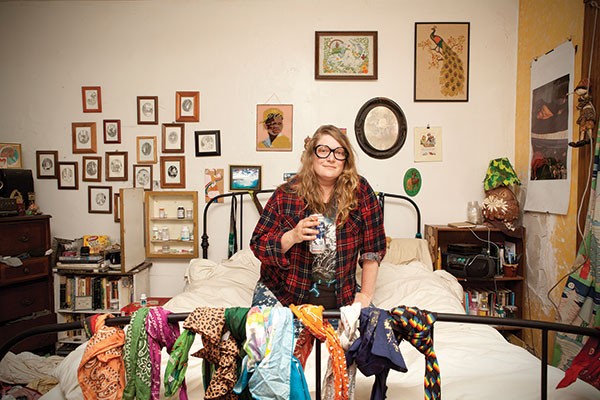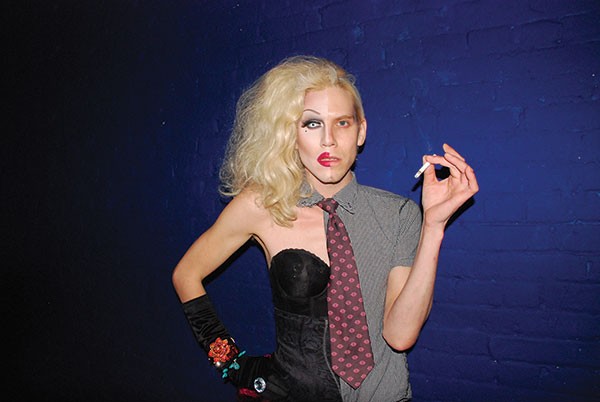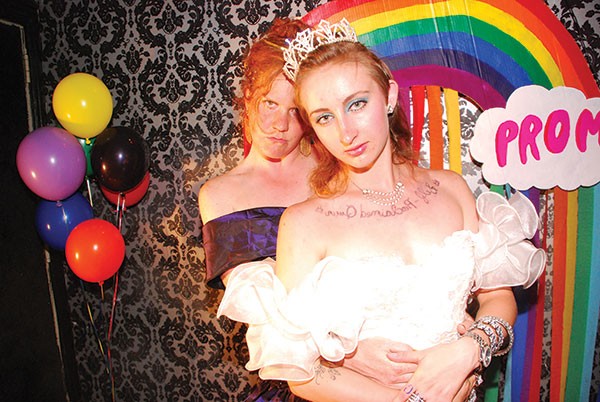Peering into artist Caldwell Linker's LGBTQ-centered photographic world is like borrowing the eyes of a professional spectator who has just fallen deeply in love.
On June 15, The Andy Warhol Museum opens Linker's solo exhibition All Through the Night, featuring 50 documentary photographs of the local LGBTQ scene. Offering a range of people, emotions and places — from public performances to bedrooms — the collection pays affectionate homage to an adventurous and thriving subculture incubated in Pittsburgh.
Linker, originally from North Carolina, is heavily influenced by feminist and queer political movements. However, "there's been lots of times that I have read about people, or groups of people or events ... and there weren't pictures," says Linker (who prefers not to be identified by gender). Linker's passion for documentary photography goes back 15 years, predating a 2007 relocation here from the Pacific Northwest. "My friends are all doing really interesting things and nobody was documenting it," says the photographer.
"Interesting," indeed: The Haus of Haunt, Pittsburgh's premier drag troupe, is enjoying a center-stage moment thanks to RuPaul's Drag Race competitors Sharon Needles (who won two seasons ago) and Alaska Thunderfuck (last season's runner-up). Riding the buzz, Linker released a self-published photography book, The Haus of Haunt: Watch Children, which also features drag queens Cherri Baum and Veruca la' Piranha. Watch Children captures the domestic lives of these drag queens, sans fards, but doesn't shy from their darker, edgier and, at times, controversial drag style, highlighting some of the nation's best drag performances.
Both Watch Children and All Through the Night illustrate Linker's dual vantage points as observer and insider/collaborator — roles that can suggest either gentle detachment or genuine engagement. Similarly, Linker's unintimidating shooting style blends rapid-fire camerawork with assisting stiletto-clad queens off stage and hugging friends at venues like Lawrenceville's Blue Moon.
Linker is seemingly never without a camera: "People don't even notice I'm holding a camera or snapping photos anymore." The results are spontaneous, intuitive and direct. "I don't take pictures of folks unless they are my close friends, and obviously are expecting to be photographed all the time," says Linker.
Linker's friends, often opulent beauties, appear to love being photographed. They're aware of not only the pleasure, but the power, immediacy and reproducibility images have in our digital age.
Some poses might offend tender viewers. One subject pees in a tub ("Sena (My Bathroom)"); a masked nude crosses Butler Street ("Alaska (Butler St.)"); panties are candidly flashed ("Rachel, Five, Elli (Party At Black Street)"). Linker doesn't create shock, but instead delivers it from pros who leverage it for political pride by jubilantly setting themselves apart from the mainstream.
Though the work deals with sensitive material — nudity, people making out (you never know who is dating who), inebriety and unflattering poses — "I try to be respectful about people's privacy," says Linker. "I always listen when people ask me to take down pictures [from the Internet]. I try really hard to only put pictures that I think are flattering on the Internet."
Access seems cultivated through Linker's membership in, and commitment to, the LGBTQ community. "It takes a truly trusted person to be able to take photographs of people with their guard down so that they read as real," says Warhol director Eric Shiner, who was taken by Linker's "honest imagery."
"Read as real": That evaluation doesn't merely acknowledge the insider's goal of "realness." It also illuminates how characters like Alaska and Sharon are constructed on reality television. Linker's oeuvre fills the gaps left by sensationalized, low-attention-span spectatorship with domestic moments — less competitive sport, more family dynamics.
And the shit definitely got real for Gregory Labon (Veruca la' Piranha) back in 2010, on the night he was attacked, in an alleged hate crime, outside a Bloomfield bar. A few days later, Linker photographed Labon's bruises. The series "Veruca After Getting Beat Up (Veruca's Shower)" carries this collection's one overt political statement by highlighting violence against queer people and the urgency for equality. The message can ambush aesthetic preoccupation, with an image at once voyeuristic and punishing: It feeds you drama with one hand, and slaps you in the face with the other.
Linker's visual and conceptual antecedents include Nan Goldin, whose 1980s snapshot diaries of friends and lovers are built from frayed emotional obsessions; and Brassaï's erotic 1930s Parisian cabaret and café night scenes of prostitutes, lovers and transvestites. Among young contemporary photographers, Mike Brodie's depictions of his fellow freight-hoppers romanticize American 21st-century vagabondage.
For decades, documentary's standing in the art world has been diminished by debates about representation — about whether social realism is attainable by the artist or is infinitely (mis)interpreted by audiences. Nonetheless, Linker and Brodie are among those imperative image-makers whose work distinguishes human diversity flourishing just under the mainstream radar.




